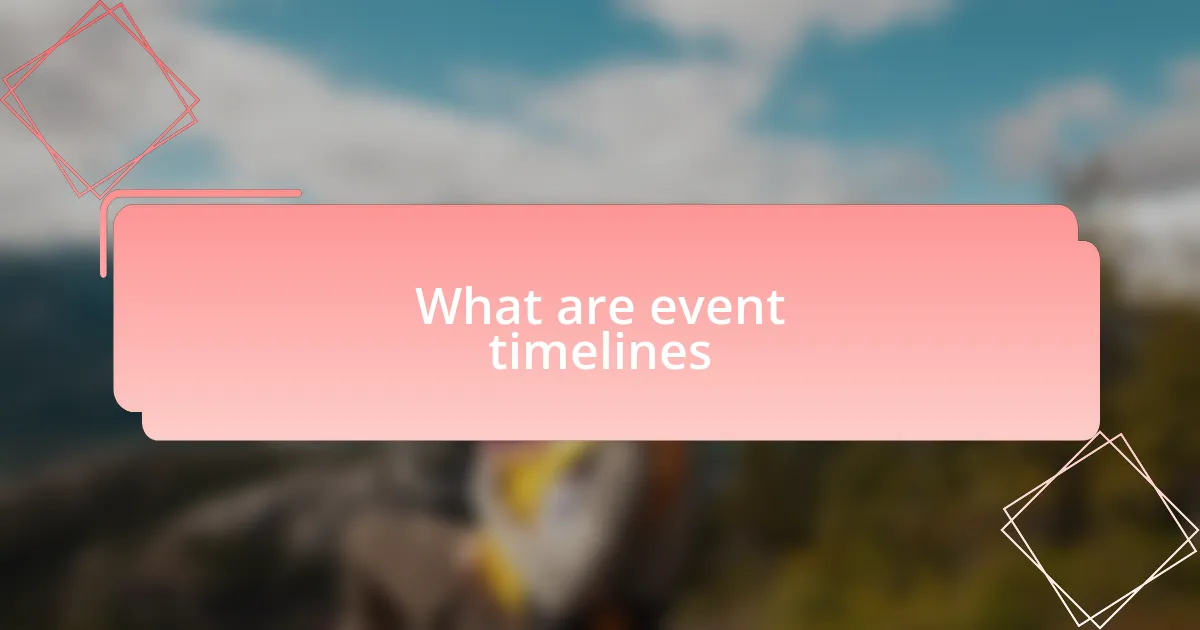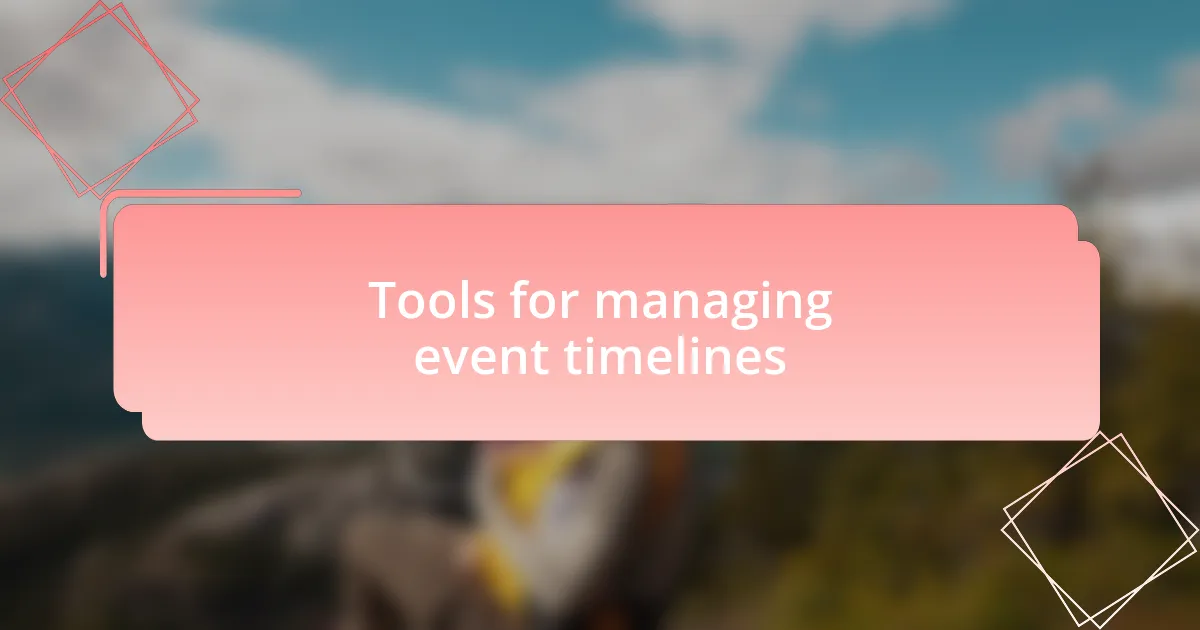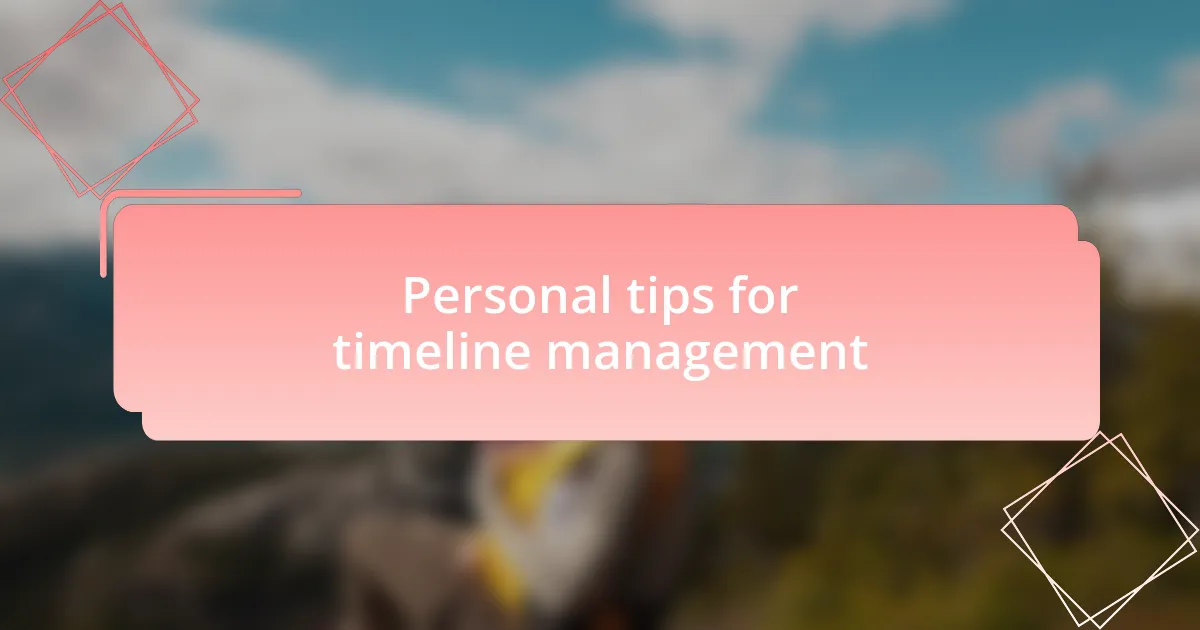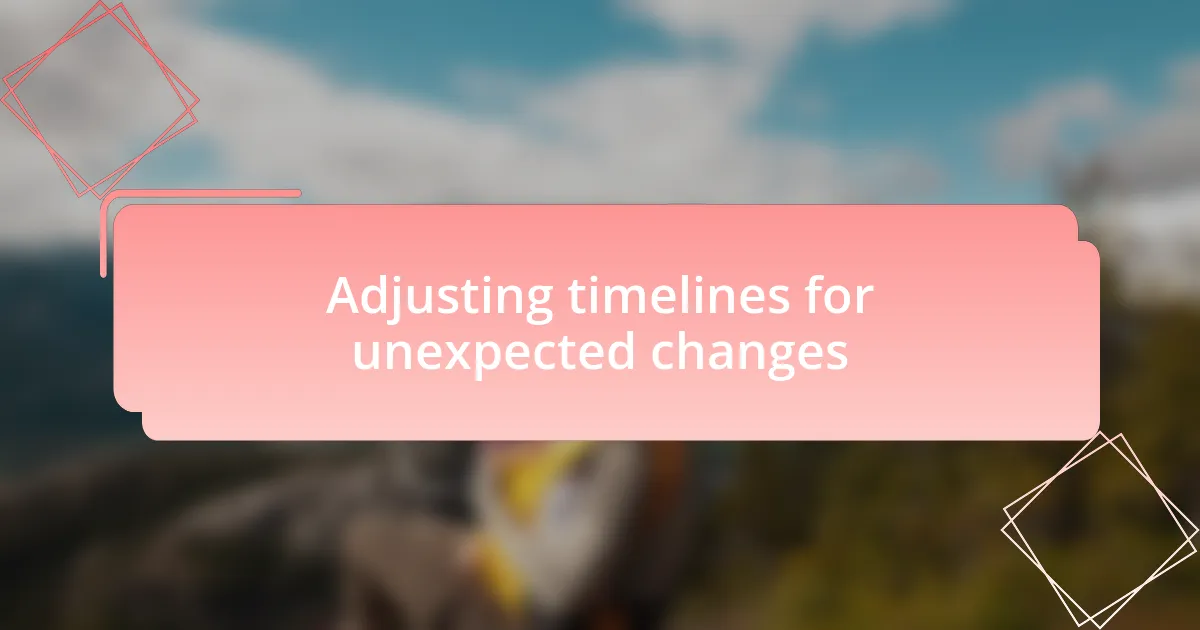Key takeaways:
- Event timelines are essential for organizing and managing tasks, ensuring participants remain aligned toward a common goal.
- Effective timelines include clear structures, specific deadlines, and adaptability to accommodate unexpected changes.
- Utilizing digital tools like project management apps and shared calendars can enhance collaboration and accountability in planning.
- Breaking tasks into smaller, manageable chunks and setting strict deadlines improves focus, reduces stress, and increases the likelihood of successful event execution.

What are event timelines
Event timelines are essentially structured outlines detailing the sequence of activities for a specific occasion. Think of them as blueprints guiding all participants and organizers toward a shared vision; they help ensure everyone is on the same page. Have you ever felt the chaos of an event without a clear timeline? It’s a feeling I wouldn’t wish on anyone.
In my experience, well-crafted event timelines break the entire planning process into manageable segments. Every task, from sending invitations to arranging decorations, finds its place on the timeline, providing a sense of control. I still remember the panic I felt before a Mother’s Day celebration when I realized I had missed key deadlines. A simple timeline could have saved me from that overwhelming moment.
What’s fascinating is how event timelines can also serve as a reflection of personal values and priorities. They’re not just about logistics; they’re about storytelling. When I think back to one Mother’s Day, the timeline wasn’t just a schedule; it represented the love and effort poured into creating a memorable experience. Wouldn’t you agree that organizing events is as much about emotion as it is about planning?

Importance of event timelines
An event timeline acts as a reliable compass, guiding each moment toward the fruition of what we’ve envisioned. I can recall one Mother’s Day where I relied heavily on a detailed timeline. Without it, coordinating flower deliveries and coordinating guests would have turned into a chaotic scramble rather than a beautiful celebration. Isn’t it comforting to have a structured plan to alleviate those uncertainties?
When I think about the importance of event timelines, I often reflect on how they anchor us during the planning whirlpool. One year, faced with last-minute changes, my timeline served as my lifeline. The moment I consulted it, my anxiety eased. It provided clarity in the chaos—reminding me of what needed to be done next and prioritizing my tasks in such a way that my focus remained sharp. Wouldn’t you agree that having a plan can transform an overwhelming situation into a series of achievable steps?
Moreover, event timelines enrich the overall experience. They allow us to look ahead, to anticipate not just tasks but emotions and moments that will unfold during the event. I remember the sense of accomplishment I felt when everything went according to the timeline on Mother’s Day. It wasn’t just about getting things done; it was about weaving a rich and emotional tapestry of memories, ensuring every detail counted. How could we not appreciate the role of a timeline in crafting those unforgettable experiences?

Key elements of effective timelines
A clear structure is essential when creating an effective event timeline. It helps to break down each stage of the event, from planning to execution. I often use a digital calendar to plot my timeline, allowing me to shift tasks easily. I can think of a particular Mother’s Day where I had to adjust the delivery time for a tasty cake. With everything laid out clearly, I was able to seamlessly change my plans without feeling stressed.
In addition to structure, the inclusion of specific deadlines is crucial. Each task should have a designated completion date to avoid last-minute chaos. I learned this the hard way during a family gathering when I neglected to set a deadline for my cousin’s speech. With no prompts, the speech was unprepared, leading to an awkward pause. This experience taught me how important it is to designate clear timelines within my planning—tasks shouldn’t linger without a due date.
Finally, I believe that adaptability is a vital element of effective timelines. Events seldom unfold exactly as planned, and having a flexible timeline can be a true game-changer. I recollect a Mother’s Day where unexpected weather forced us to change locations last minute. My ability to pivot while referring to my timeline made that transition feel almost effortless. Isn’t it reassuring to know that a well-crafted timeline not only sets you up for success but also prepares you for surprises along the way?

Tools for managing event timelines
There are several tools that I turn to when managing event timelines, and digital project management apps have become my favorite. These applications, such as Trello or Asana, allow me to create boards that visually represent my tasks. I remember using Trello for a Mother’s Day brunch last year; I could easily drag and drop tasks as I checked them off, which provided a satisfying sense of progression.
Another fantastic resource is shared calendars, like Google Calendar. I often invite family members to collaborate, ensuring everyone is on the same page. When planning that memorable Mother’s Day surprise, being able to see everyone’s availability eliminated any guesswork. Did you know that syncing the calendar with reminder settings can help prevent slipping deadlines? I found that when I receive a notification, it keeps me accountable and focused.
Lastly, I can’t emphasize enough the importance of checklist apps. They may seem simple, but I find their effectiveness to be unparalleled. While creating my to-do list for Mother’s Day gifts, I realized how satisfying it was to check each item off. Why is this so important? A checklist provides not only a sense of accomplishment but also a visual representation of my progress. Trust me, seeing those boxes ticked feels like a personal victory each time!

Personal tips for timeline management
When it comes to managing timelines, I find that breaking everything down into smaller, manageable chunks is crucial. For instance, during a past Mother’s Day planning session, I divided the week leading up to the celebration into specific tasks, like ordering flowers one day and finalizing the menu the next. This not only made it less overwhelming but also allowed me to celebrate small wins along the way. Have you ever noticed how focusing on one task at a time can reduce stress tremendously?
I also swear by setting strict deadlines for myself. Recently, while planning a surprise dinner for my mom, I gave myself deadlines for ordering gifts, creating invitations, and preparing decorations. I often ask myself, “What’s the latest I can accomplish this task?” This method pushes me to stay on track, as I visualize the end goal of making my mom feel cherished. The excitement that builds as I tick each task off my list keeps my motivation high.
Lastly, regular check-ins with myself have proven invaluable. I make it a habit to take a few moments each day to review my progress and adjust my timeline as needed. It’s like having a personal meeting where I assess what’s working and what needs tweaking. Have you tried reflecting on your progress? This simple practice gives me clarity and reminds me to stay focused on what truly matters—creating lasting memories for my mom.

Adjusting timelines for unexpected changes
When unexpected changes arise, flexibility is key. I remember one Mother’s Day when the florist I had relied on suddenly canceled my order. Instead of panicking, I quickly revisited my timeline and sought out alternative options. This moment taught me the importance of having a backup plan, whether it’s having a list of alternative vendors or being ready to pivot the celebration entirely.
There’s always a chance that guest lists might change at the last minute. During one event, a few friends couldn’t make it, which left me rethinking the seating arrangement. I adjusted my timeline by giving myself a few extra hours to reconfigure everything. It was a learning experience in adaptability, and I realized that embracing change often leads to an unexpected joy in the celebration. Have you ever had to improvise on the fly? I found that these moments often turn out to be the most memorable.
Ultimately, I see unexpected changes as opportunities rather than setbacks. During a past celebration, the unexpected rainstorm forced us to move our outdoor brunch indoors. This shift in the plan sparked my creativity, and I transformed our living room into a cozy brunch spot. Reflecting on that day, I realize that embracing adjustments can enhance the experience for everyone involved, leading to cherished memories filled with laughter instead of stress.